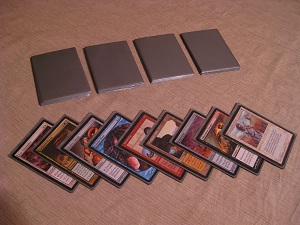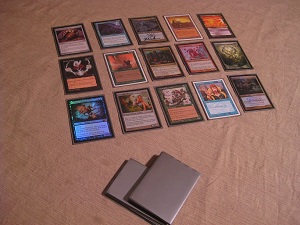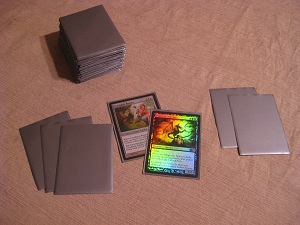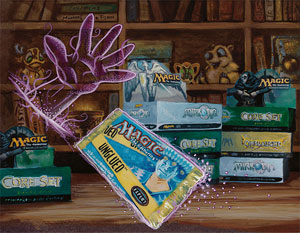
Loyal readers, I appreciate that you've waited around for me. It's been longer than I anticipated since my previous article. Back then I gave a view into the creativity and engineering that goes into an unconventional cube. It's a topic near and dear to my heart, but some of you may have found it to be a bit abstract. Dear readers, fear not; this time I'll be very concrete.
There will always be more to say about cube construction. It's a deep and ever-evolving science and my primary pursuit in Magic. I'm continuously refining my cube as an interesting and balanced drafting environment. I learn things along the way and I have every intention of sharing my experience with you. But building a cube is worthless if you don't know what to do with it.
"That's obvious," you may say. "You draft it!" Eloquent reader, you are astute. You can deal out packs of fifteen, draft them, and play just like you would at your neighborhood Saga-Legacy-Destiny event. It'll be a blast. However, just like last time, I want to encourage you to spice things up. There are plenty of other things that you can do with a cube. What follow are some of the formats I've got the most experience with, as well as a few tidbits of wisdom I've picked up about them.

You've just cracked your first pack.
Most cubes, most of the time, are probably used for plain old drafting. Though they can in principle be of any size. It's common to have a cube fall at exactly 360 cards - that is, enough to support an eight-player draft with three packs of fifteen each. Having fewer cards of course means supporting fewer players. It's quite rare. A larger cube adds variety at the expense of archetypes which require specific support. For example, you wouldn't want to draft Honden control if you didn't know how many of them were in the card pool being drafted. It's not uncommon for cubes to be built with the capability to support ten or even twelve players. In principle, however, the mechanics of drafting are unchanged by the size of the cube.
If you're drafting with eight players then dealing out three packs of fifteen works very well. However, I often find myself drafting with six or even four players. In that case I usually elect to give each player five packs of nine instead. Smaller packs are more likely to have wonky color ratios. Color signaling is a bit less reliable. I like to think that problem is balanced out by having an extra pair of first picks. The primary reason to use more, smaller packs is that it's not exciting to see the same cards table time and time again. If something triple wheels to you, do you even want it anymore?

What will you pick with everyone watching?
Some of you may be unfamiliar with this type of draft; it's very simple, so I'll run it down for you. Each player is dealt their packs as in an ordinary draft. However, rather than each player opening up a pack simultaneously, only one pack is cracked at a time. All of the cards are laid out on the table, face up. In pick order, each player chooses a card and places it face down in their pile. Once the pack is exhausted the next person lays out a new one and pick order reverses. It will take a while to get through all of the packs.
Rochester drafting is very skill- and memory-intensive. If you can remember what everyone is picking then you can try to pick up an underdrafted archetype or color. If you pick color intensive cards, say, Teferi, Mage of Zhalfir and Future Sight, you're sending clear signals to everyone of what color you intend to pursue.
In cube, as opposed to something like M10 or Zendikar, there's often no obvious first pick. Compared to sealed product, it's typical for boosters dealt from a cube to have a more uniform power level, or at least be harder to judge due to deeper layers of synergy. How good is that Life from the Loam? It's hard to say. How likely is it to table? That probably depends on how many cycling lands you've seen the other players pick up.
An interesting variant of the Rochester draft is to skip the dealing out of boosters. Just lay out the whole cube and go at it – Rotisserie draft. In this case, at a table of eight, pick order goes as follows: 1, 2, ... 7, 8, 8, 7, ... 2, 1, 1, 2, and so on. That is, picks proceed in order for one full rotation then reverse, starting with the person who last picked. Picking last may seem like a disadvantage, but picking twice in a row can allow you to send some very strong signals about what you're going to be playing (and a warning that you'll cut off anyone who tries to get in your way).
In practice, Rochester drafting a conventional cube is a lot like drafting all of Magic. Whatever card you want, it's probably in the cube. Unconventional cubes are a bit trickier. I'll bet it's not very helpful if I tell you "name any uncommon you want, other than the few I've cut for power reasons." Just remember that even experienced cubers will have to climb a bit of a learning curve when faced with drafting a new cube.
Since laying out several hundred cards demands a lot of effort and horizontal space, it's not often implemented. It makes more sense to sort the cards, perhaps by color, then search for what you want. If you're even less organized, just break the cube up into chunks. When someone declares what they want, each person grabs a chunk and starts searching frantically.

will that next pile be better?
The Winston draft is one of my personal favorites, in no small part because it works well with as few as two people. I'm can't claim to be an expert, but I can explain how it works.
Grab a chunk of your cube. The number you need depends on the cube, and of course the number of players. In my cube I need about 100 cards for two people but you might be able to get away with fewer than 50 cards per person as you accumulate more drafters. Put that chunk in the middle of the table. Take the top card and place it in stack A. The next card goes in stack B and a third is stack C. All cards are face down.
The first drafter looks at stack A. They can either take the stack or put it back and add a card from the top of the chunk. If they put it back, they do the same with stack B. If they don't like the selection there either they can repeat it one more time with stack C. In the event that all three stacks are unsatisfying, the drafter gets the top card of the chunk. The draft is over when the chunk and all three piles are exhausted.
What's interesting about this is that you weigh quality against quantity. Sure, you'll pass up stack A if it contains only Sturdy Hatchling. But what if it also contains Tresserhorn Sinks, Wishmonger, and Jodah's Avenger? None of those cards are as exciting as the Bloodbraid Elf you might find in the next pile. But when it comes time to build a deck, if my pool is three times the size of yours, I'm probably going to make a better one than you are.
This is another format where it pays to have a good memory. At any point in the draft you've seen a lot of the face down cards in each pile. If you can keep track of what's in the piles taken, even though you won't know their entire contents, you can speculate pretty effectively about what your opponent is drafting.
Sealed Decks
You may notice that I'm focusing in particular on formats that lend themselves to having fewer players than eight. That's because my core group of drafters is small so I rarely end up with a full eight. Sealed is certainly another format conducive to small groups since it's twice as card intensive as your run of the mill draft. Rather than dealing out 45 cards to each player divided between packs, give each player a stack of 90 cards (that means that in a 360 card cube only four players can play sealed at a time). Players build decks from those pools.
Sealed is probably the most straightforward way to play a cube. It's also the quickest. Dealing out pools is much faster than drafting. But with that convenience come some hazards as well, particularly in cubes where combo is a supported archetype.
Sealed decks tend to run in a pretty straightforward way; you'll probably be playing midrange or control. Once in a while you'll have a fast pool and get away with aggro. Playing combo is extremely difficult. Because of this, my uncommon cube is great for sealed. There's plenty of synergy but a dearth of narrow combo staples. Given a card in your pool, if you have support in that color, you can probably play it.
That's not the case in all cubes.
A friend of mine has an artfully constructed cube. It creates exciting drafts but poor sealed pools because of a high density of build-around-me cards. In his cube, Patriarch's Bidding is a high pick, provided it's drafted early enough that you can start grabbing all of the Goblins. Similarly, if you open Tinker or Standstill you'll want to sculpt your draft to optimize those cards. In a sealed pool you have what you're dealt. As a result, odds of being able to play cards so dependent on absurd synergies become unplayable.
It's frustrating; those cards are in there to be used, and there's nothing worse than having your favorite card in your sealed pool but no support for it.
Team Sealed
Team Sealed is a variant of Sealed Decks. It may have struck you that in Sealed each player will use only about a quarter of their card pool. That's not very efficient. Instead of building decks as individuals, split into teams of two and deal a 90 card pool to each team. The team works together to build two decks. Everyone plays against each of their opponents (that is, everyone but their teammate). If you're so inclined you can determine rankings based on team score.
In principle you could play Two-Headed Giant with your team sealed pool. I'll discuss multiplayer formats later in the article.

Team drafting is just what it sounds like: drafting, but with teams. Divide your players into two teams then seat alternating. Draft and build decks as normal (no swapping cards with teammates!) then pair off. When your rounds end, grab a new opponent from the other team. If each team has n players, the first team to get more than half of n² wins is victorious. In the rare case that the matches come out dead even, each team secretly selects one of their players. The chosen players duel as a tie breaker.
Team drafting appeals particularly to those of us who enjoy drafting and deck construction more than just playing a ton of games. That is, it drastically cuts down on the number of rounds played with a given draft pool, allowing you to do more drafts in an afternoon.
Drafting as a team is also a decent thing to do when there's a high disparity of skill among the players you draft with. If Matthias is unstoppable with your cube but Sally drops every match, do a team draft from time to time with the two of them on the same team. You'll see Matthias suddenly take an interest in helping Sally become a better player.
Rather than alternating drafters from team to team, it's also acceptable to decide teams (usually at random) after the draft is over. It's a new experience draft when you don't know if the drafter to your left is a friend or an enemy.
Reverse Draft
Now, say you've been drafting powerhouse decks all day and absolutely crushing each other with slick mana curves and raw synergy. Care for a change? Make a contest of who can draft the worst pool. The way we do it is a bit complicated, so stick with me here.
Deal each player six packs of fifteen. Each player looks at their first pack and selects a card. Then, before passing, they remove a card at random from the pack and set it aside. Neither player will ever see the cards that get set aside. This means that about half of the cards in the pack won't end up in anybody's pool. And, because the packs have an odd number of cards, it also means that the last pick from each pack is always randomly chosen from two options.
After you draft, pass the pool you just drafted. Build a deck out of the pool you get. You're testing your deck construction chops against the mercilessness and cunning of whoever drafted that pool. It's hard; everyone is probably playing five colors. You'll be playing cards that you don't want to play, and probably cards that you don't want to play with each other. It's great.
There are a few strategies I've seen do well in this format, though how well a strategy works does depend a lot on the cube's construction.
One approach is to draft aggressive creatures with demanding mana costs in all colors. White Knight, Black Knight, Kird Ape, and their friends. Draft no fixing or dual lands. Sure, your opponent will be rocking a deck full of scary two drops... but they won't be able to start dropping them until turn four.
A riskier strategy is to take only card advantage and mana fixing. Pick all of the lands you can get your hands on. Take Harrow and Tidings. But never pick a finisher. Make sure your opponent has nothing to draw or ramp into. The risk that comes with this strategy is that the last pick from each pack is random. Once in a while you'll end up giving your opponent a pool of twenty-six nonbasic lands and a Broodmate Dragon. The rest of their deck might not really do anything, but if old Broodie gets played on turn five every game you're in pretty bad shape.

multiple opponents = sad ape
You may think that after all this hubbub about different draft formats I'll be encouraging you to do something crazy to your games. You're worried, “maybe he's going to only let me attack people wearing the same color as I am.” Don't worry. I'm not going to tell you do so anything of the sort. I'm not a strong advocate of throwing in goofy global effects or using planes or turning Magic into a drinking game. In fact, I don't even make a habit of playing games with more than two players.
When Wizards makes a set, they balance it for all kinds of Limited environments. They throw in a few cards made for constructed, too, and balance power levels with rarity. Cubes, at least those I've experienced, aren't built like that. The purpose is much more focused. In every cube I've played the intention is to enable a powerful Limited environment which creates balanced and interesting duels. Card choices and levels of support for various archetypes are tailored with two-player games in mind. As such I can't offer you much wisdom with respect to playing multiplayer with a cube.
I don't mean to say that you couldn't build a multiplayer cube. Quite the opposite; if you want to play multiplayer with a cube, you should build a cube with multiplayer interaction in mind. It will work better than trying to shoehorn your duel cube into a multiplayer format where, for example, aggro is suddenly unplayable. Playing sealed as opposed to drafting might help alleviate the situation but running multiplayer games with a duel cube will do a lot to neuter the balance you've worked so hard to put into it.
Every Rule Has Exceptions
From time to time you'll sit down with the best intentions of drafting yourself some cube and playing some duels. Suddenly, Sally goes into labor. As she hops a bus to go to the hospital, you'll find yourself to have an odd number of players.
First of all, don't make her take the bus next time. Have someone drive her, then you will have an even number again.
You can draft as normal. Then when it comes play time you'll have a few choices.
You can rotate who sits games out. In a round robin everyone has to play a match against each of their opponents, but there's no need to play all the games of that match right one after the other. Play a game, mark the outcome, then rotate. This will keep any one person from sitting out too long. You'll rotate back to each other in good time. Whoever is sitting out gets to play chef and whip up some frozen pizzas for everyone.
Alternatively, if you really want everyone to play at once, you can play a game with more than two people in it. Strictly speaking, it's multiplayer, but it's a format designed to feel most like a duel; it's called attack left. You can attack right instead if you want, I guess, it works out about the same.
Arrange everyone around a table in a circle. Look to your left. When that player dies, you win. When anyone wins, everyone else loses. It's as simple as that.
Compared to a traditional free for all multiplayer game, the politics are greatly diminished. Everyone just has to kill one other player. The way this gets interesting is that there is no restriction on targeting range. There isn't even a restriction on who you can attack... but if anyone other than the player immediately to your left dies, you lose. That means that if someone is getting beaten down, you're suddenly going to take an interest in protecting them.
This variant works great with exactly three players. Aggro is still a viable strategy since you only have to kill one opponent. As you accumulate more players, however, the game slows down. You get further and further away from what the cube was built for. Like I said, I don't recommend big multiplayer in a cube built to duel.
That's All For Now
I'd love to hear about what you've tried with your cube, which formats it's great for, and which don't work. Now get cubing!
Comments